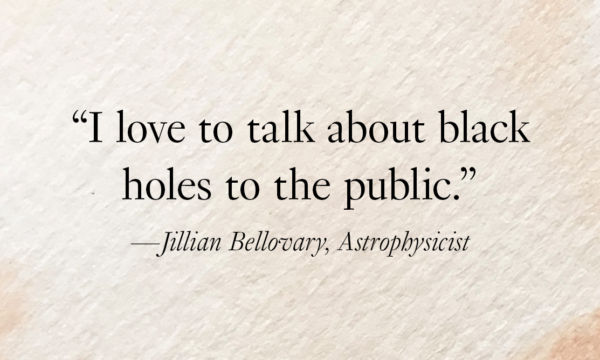So, What Do You Do? Part 6: Debbie Irwin, Voiceover artist
March 21, 2019 | Filed in: Your Brain
“So, What Do You Do?” is an MM series featuring extraordinary women in the kinds of jobs that make you sit up and say, “What’s that like?” Every week, another original entrepreneur, executive, artist, or scientist will own the answer by sharing what she does, how she does it, and why she does what she does. Up this week, voiceover artist Debbie Irwin on sounding “pretty,” investing in client relationships, and giving voice to the Statue of Liberty.
You might not recognize Debbie Irwin’s face, but you probably know her voice. The Manhattan-based voiceover artist has lent her talents to some of the country’s most important museums, pharmaceutical companies, major nonprofits, and research institutes.
Irwin grew up in Chicago and attended first the University of Chicago, then Brown University, acting in shows both on campus and off. When she graduated, after a year of crying and cocktail waitressing at a disco, she made her way to New York City to pursue her dream of becoming a stage actress. When soap operas and children’s theater didn’t accelerate her career, she went to Wall Street and became a successful stockbroker for Dean Witter and Smith Barney. Five years later, she left to be a full-time mom. Irwin credits her mother with pushing her back into the workforce. When her kids were 13, 11, and 8, Irwin took her first voiceover class and knew she’d found the right fit.
Here’s just some of what she does in a day:
Wakes up and feels guilty for exactly one second that she’s not starting her day with a gratitude prayer or moment of meditation.
I check my computer first thing to see if any clients have contacted me; complete the New York Times mini-crossword puzzle; take in a little morning news; and grab a cookie and a cup of coffee.
Squeezes in a 90-minute yoga class and then gets to work.
I rush back from yoga to audition and complete jobs. If there are any critical auditions, I try to get my voice warmed-up so I don’t sound like a trucker—unless the script calls for it! Or I start recording one of my projects, either in my own studio or, preferably, in an outside studio. That way I am just the talent and don’t have to be the sound engineer, too.
Gets crazy cool assignments.
Being the voice of the Statue of Liberty was pretty cool [Irwin is the official voice of Lady Liberty on the landmark’s audio tour]. I played the voice of God at a live awards show, and I narrated a pitch for a research project for Johns Hopkins University that resulted in a $50 million-dollar grant. I’ve voiced narrations for the PBS Treasures of New York series. I love animal behavior, travel, and the sciences, so it would be awesome if I could narrate documentaries for TV shows.
Fields plenty of workaday stuff as well.
Throughout the day, I handle inquiries for projects and calls from agents. I also have a variety of ongoing projects such as writing articles for Backstage and blog posts and developing presentations on medical narration. Many people think that doing voiceovers is pretty cool, so there’s often a wow response when people learn what I do. But I know that I’m just one part of the entire production and the collaboration is greater than the sum of its parts. There is the daily grind of auditioning and not getting cast, hundreds of times—this work is extremely competitive, especially now that you can do it from the comfort of your own home.
Works hard to avoid slipping back to her default mode: “pretty.”
I’m still learning how to remove the patina of performance from my voice so that it’s the raw, real me at the mic, instead of a woman with a pretty voice veneer. I was in a session where the client said, ‘Your voice is lovely, but we don’t want it to sound so pretty.’ I needed to be more real, natural, conversational, less polished. Less Ginger, more Maryanne.
Brings her hard-won expertise.
Reading a script in a pleasing voice is not voice acting. VO work is character acting, with facial expression and physicality. The more the body moves, the more natural the voice is. VO professionals understand what role they are inhabiting, who they are talking to, why they are saying what they are saying, and the context for the conversation. It’s a lot more than reading words on a page.
Replenishes her stash of little gifts for people she likes.
I give ‘happy happies,’ which is what my family calls gifts that are given for no particular reason, to clients and colleagues. ChapSticks, pencils, pens in the shape of microphones, mugs with common directions we hear (“more smile, upbeat, natural”), Vosges chocolate, Jeni’s ice cream, whatever is appropriate and appreciated.
Keeps her values alive.
My top three values are excellence, relationships, and honesty. My commitment to excellence helps me deliver top-shelf service to my clients. I am invested in getting to know my clients and believe in staying in touch so we have long-term relationships. If everyone feels heard, there’s a foundation of trust that gets built and you can feel good laying your head on the pillow each night.
Basks in the glow of sincere compliments.
The best ones I’ve heard on the job are ‘You nailed it!’ ‘I can’t wait to work with you again!’ ‘You made my job so easy!’ ‘We love your voice!’ These are the things that make me feel great.
Repairs to the country on the weekends.
I’m up in the Berkshires—gardening, entertaining, participating in events with the Hancock Shaker Village, the Columbia Land Conservancy, or visiting Cantina 229, my son’s cool farm-to-table restaurant in New Marlborough. My grandson is the light of my life. Our adult daughters often visit, so we are still together as a family much of the time.
Focuses on the important stuff at the end of the day.
I want to be remembered for being kind, generous, funny, talented. And most of all, for helping to create three healthy, happy human beings—my kids.









